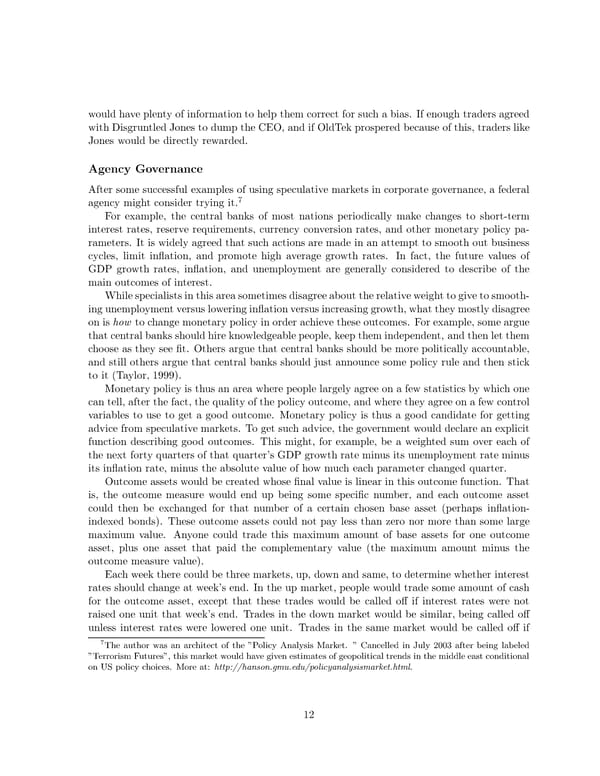would have plenty of information to help them correct for such a bias. If enough traders agreed with Disgruntled Jones to dump the CEO, and if OldTek prospered because of this, traders like Jones would be directly rewarded. Agency Governance After some successful examples of using speculative markets in corporate governance, a federal agency might consider trying it.7 For example, the central banks of most nations periodically make changes to short-term interest rates, reserve requirements, currency conversion rates, and other monetary policy pa- rameters. It is widely agreed that such actions are made in an attempt to smooth out business cycles, limit inflation, and promote high average growth rates. In fact, the future values of GDP growth rates, inflation, and unemployment are generally considered to describe of the main outcomes of interest. Whilespecialistsin this area sometimes disagreeabout the relativeweight to give to smooth- ing unemploymentversusloweringinflationversusincreasing growth,what they mostly disagree on is how to change monetary policy in order achieve these outcomes. For example, some argue that central banks should hire knowledgeable people, keep them independent, and then let them choose as they see fit. Others argue that central banks should be more politically accountable, and still others argue that central banks should just announce some policy rule and then stick to it (Taylor, 1999). Monetary policy is thus an area where people largely agree on a few statistics by which one can tell, after the fact, the quality of the policy outcome, and where they agree on a few control variables to use to get a good outcome. Monetary policy is thus a good candidate for getting advice from speculative markets. To get such advice, the government would declare an explicit function describing good outcomes. This might, for example, be a weighted sum over each of the next forty quarters of that quarter’s GDP growth rate minus its unemployment rate minus its inflation rate, minus the absolute value of how much each parameter changed quarter. Outcome assets would be created whose final value is linear in this outcome function. That is, the outcome measure would end up being some specific number, and each outcome asset could then be exchanged for that number of a certain chosen base asset (perhaps inflation- indexed bonds). These outcome assets could not pay less than zero nor more than some large maximum value. Anyone could trade this maximum amount of base assets for one outcome asset, plus one asset that paid the complementary value (the maximum amount minus the outcome measure value). Each week there could be three markets, up, down and same, to determine whether interest rates should change at week’s end. In the up market, people would trade some amount of cash for the outcome asset, except that these trades would be called off if interest rates were not raised one unit that week’s end. Trades in the down market would be similar, being called off unless interest rates were lowered one unit. Trades in the same market would be called off if 7The author was an architect of the ”Policy Analysis Market. ” Cancelled in July 2003 after being labeled ”Terrorism Futures”, this market would have given estimates of geopolitical trends in the middle east conditional on US policy choices. More at: http://hanson.gmu.edu/policyanalysismarket.html. 12
 Shall We Vote on Values, But Bet on Beliefs? Page 13 Page 15
Shall We Vote on Values, But Bet on Beliefs? Page 13 Page 15